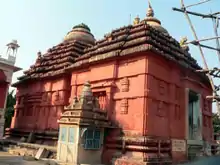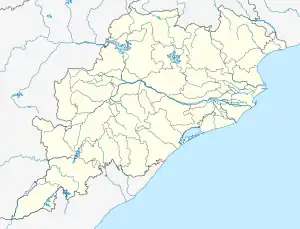| Digambar Jain Temple, Khandagiri | |
|---|---|
 Digambar Jain Temple, Khandagiri | |
| Religion | |
| Affiliation | Jainism |
| Deity | Parshvanatha |
| Festivals | Mahavir Jayanti |
| Governing body | Bengal, Bihar and Odisha Digambar Jain Tirthkshetra Committee |
| Location | |
| Location | Bhubaneswar, Odisha, India |
 Location within Odisha | |
| Geographic coordinates | 20°15′43″N 85°47′10″E / 20.26194°N 85.78611°E |
| Architecture | |
| Style | Kalinga architecture |
| Date established | 12-13th century CE |
| Specifications | |
| Temple(s) | 3 |
| Elevation | 87 m (285 ft) |
Digambara Jaina Temple is a Jain temple in Bhubaneswar, in the state of Odisha, India. The temple is on the top of Khandagiri hill. This hill is honeycombed with a series of rock-cut Jaina caves, commissioned by King Kharavela in the 1st century BCE. The rock-cut caves are protected by Archaeological Survey of India. The enshrining deities are a series of Jaina tirthankara images.
History
The architecture of the temple suggest that it was built out of materials from an earlier temple. According to local legends the temple was constructed by Mahameghavahana ruler Kharavela in the 1st century BCE. This legend is not supported by the architectural features.[1] According to Alexander Cunningham, The temple structure is estimated to have been built during the rule of Maratha Empire based on architecture design.[2] The current structure was built in first quarter of the 19th century.[1][3]
Architurecture
This temple is built in Pidha style with Vimana and Jaga mohan following the Kalinga architecture. The temple is built using sandstone in Ashlar fashion with triratha plan and tri-anga bada elevation. The vimana and jagamohana features balustrade windows with vimana follows a square plan and Jaga mohan follows a rectangular plan. The architectural motifs such as khakharamundis and pidhamundis in the lower and upper janghas respectively.[4]
The temple complex consist of three temple, first temple houses a colossal black stone idol of Parshvanatha in a white marble hall.The main shrine houses a white marble idol of Mahavira along with a large number of Jain idols. The third shrines houses 5 images of Jain tirthankara.[5]
Conservation
The temple is maintained by the Bengal, Bihar and Odisha Digambara Jaina Tirthankara Committee. Bimala Devi Jain is the local caretaker.[1]
See also
References
Citations
- 1 2 3 IGNCA & Digambara Jaina Temple, Khandagiri, p. 2.
- ↑ Cunningham 1877, p. 27.
- ↑ "Modern Jain temple on the summit of Khandgiri Hill". British Library. Retrieved 2 July 2022.
- ↑ IGNCA & Digambara Jaina Temple, Khandagiri, p. 3.
- ↑ Javid & Javeed 2008, p. 40.
Sources
- Javid, Ali; Javeed, Tabassum (2008), World Heritage Monuments and Related Edifices in India, vol. 2, Algora Publishing, ISBN 9780875864839
- Cunningham, Alexander (1877), Inscriptions of Asoka, Office of the Superintendent of Government Printing
- Pradhan, Sadasiba (2009). Lesser Known Monuments Of Bhubaneswar. Bhubaneswar: Lark Books. pp. 1–2. ISBN 81-7375-164-1.
- Cultural Informatics Laboratory. "Indira Gandhi National Centre for the Arts" (PDF). Ignca.nic.in. Retrieved 6 August 2014.